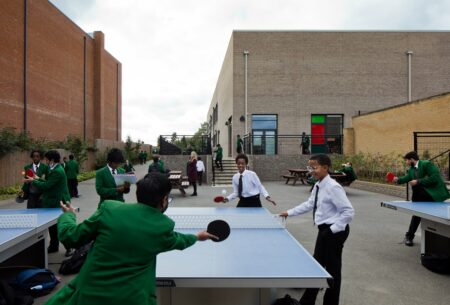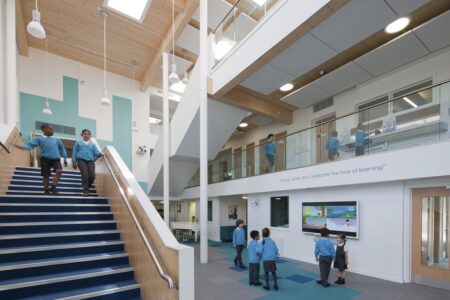Design implications of educational settings
Rachel Moulton, regional practice director for education and life sciences at architectural practice, HKS, looks at the impact of the Department for Education’s new Construction Framework 25 (CF25), which is set to come into effect later this year, and how design standards may focus on brain health and stress levels for pupils and staff

Rachel Moulton
The best education environments build belonging.
Through thoughtful design, we can craft equitable learning environments that offer all learners enhanced opportunities and outcomes.
At HKS Architects we have provided education design across all levels and areas of education, from nurseries to schools, both state and private; to further, higher, and vocational education settings, and we have seen first-hand how the built environment has a direct and measurable impact on learning and academic attraction, retention, and wellbeing.
No matter the project, good design can foster learning and cultivate connections.
We are continuously learning from past experiences, projects, and data from the broader education sector, be they successes or missteps.
This provides us with valuable findings, which examine the impact on learners, visitors, and teaching staff, and it is this research which will drive forward educational learning environments and school campuses in the next 10, 20, and 50 years.

Salvatorian College. Image, Kristen-McCluskie
Safety first
Currently the state school estate in England is in a less-than-perfect shape, with significant challenges affecting both pupil safety and the learning/teaching experience.
The most-recent data available from the National Audit Office from 2023 outlines that many schools are struggling with outdated facilities, poorly-maintained infrastructure, and a lack of resources to modernise or repair them.
This report outlines that over 700,000 learners are being educated in schools that the responsible body or Department for Education believes require major refurbishment or rebuilding.
And these issues not only impact the physical safety of school environments, but also create barriers to effective teaching and learning.
For many schools, the buildings themselves are simply not fit for purpose in the 21st Century, which only adds to the pressure faced by teachers and learners, who deserve better.
This is a prime opportunity as an education sector for us all to make improvements which set the tone for the future of education.

Whitefriars Community School. Image, Kristen McCluskie
Inclusive design
The DfE procures the majority of its capital works to the school estate in England via their current Contractor’s Framework C21; but this is due to expire in November 2025.
The DfE is therefore currently procuring the Contractors Framework 25 (CF25), which will have a term of six years, and, from discussion in the premarketing engagement sessions, will use a different value banding from the previous iteration.
As part of the new framework the DfE is also due to issue a new specification for their projects, and as specialist education designers we have many hopes for the new specification.
The previous Spec21 brought forward great new sustainability deliverables, with all new schools requiring to be net zero carbon in operation (NZCiO), which we expect to continue in the new specification.
However, we are also hoping the new specification will incorporate more elements of inclusive design, alongside biophilia.
Both of these bring measurable improvements to school environments, and their users, but also learning attainment.
Education spaces over the past decades, although still focused around group/assembly spaces and classrooms, have changed across time.
At HKS we are seeing a return to the older values of the mid-20th-century school typologies, as we focus again more on physical and mental wellbeing for upcoming digital generations, reflecting a similar focus in post-war Britain.

Salvatorian College. Image, Kristen McCluskie
Talking technology
Current education research from our team, as well as that of our peers are frequently looking to design tools to improve spaces, experiences, and educational outcomes.
Design needs to suit the requirements of the digital generations, while also adapting to changes in pedagogy that the technology itself brings.
There is also an eye on the environment and wider climate situation, with regenerative design and principles being richly discussed, building on the NZCiO stance of the previous framework.
In the 21st Century we need to provide schools that are accessible to everyone, in all aspects, including neurodiversity.
Providing such schools requires the involvement and buy-in of all design and construction disciplines throughout the entire process, from initial sketches to building handover and post-occupancy evaluations.
Key areas which provide the widest benefits include entrance and circulation areas, as well as learning spaces.
It is key that design allows for an element of choice within schools for those who find a particular type of environment more comfortable than others.
This may include minimising graphic patterns and clutter, or ensuring that lighting cannot flicker, or that acoustics are designed to provide a calm environment.
Side spaces should enable flow and wider circulation, ensuring everyone can feel comfortable and calm, while also building social relationships through increased social interaction and a reduction in bullying and undesirable behaviour.
Incorporating measures such as these within the DfE CF25 are necessary to send the message of what is now a standard expectation in UK school design.

Canary Wharf College East Ferry. Image, Kristen McCluskie
Back to nature
Similar can be said for a focus on biophilia, where access and viewpoints to nature reap genuine benefits in the classroom, and to the wellbeing of all users, while also enhancing the environment and the biodiversity of our school campuses.
Creating a view into nature from a learning space is proven to increase creativity and attention restoration, as well as reducing stress recovery times.
With regards to attainment, there is also evidence that learning improves when there is visibility or access to nature.
Furthermore, bringing natural materials and finishes into environments, including textures and colours is proven to increase the selective attention in learners, improve the cognitive and productivity performance of teaching staff, as well as improving the wellbeing, motivation, and positive emotions of all users.
One of the key challenges we still face as a sector is that often the available sites are very constrained, particularly those in towns and cities.
More guidelines and research in the CF25 on how we can provide external facilities that best complement these enhanced internal learning environments and continue to support the health of the learners and staff would be welcomed.
When in the construction phase, projects are also frequently undertaken on live school sites, and an important factor to consider is how a development impacts the education of those learners during construction.
This should be considered at the early design stages to ensure any need to provide temporary teaching facilities is minimised, unless necessary.
We must also consider acoustic disruption and the length of a construction programme, as these can equally be disruptive to learning, alongside increasing class transitions between lessons and impacting external play.
However, we are constrained by external factors such as government funding and the budgets available to achieve the changes in design we feel are required to provide the best inspiring learning environments.
As designers we must ensure projects are not driven by solely one factor, such as sustainability, but still deliver exceptional learning spaces.
The answer to this is engagement and collaboration – which should be at the heart of any design process, whether it is a school, hospital, hotel, residence, or any building typology.
As a sector, if we can embrace the upcoming CF25 to influence our future schools at every stage of the process, from design through to construction and completion, we have an opportunity to surpass current school designs and create more-welcoming and inclusive environments to learn and work while also providing influential biophilic design and access to nature at the heart of this.
